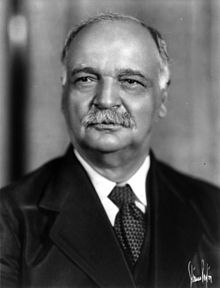
In 1928 Charles Curtis of Kansas was elected Vice-President of the United States, on the same ticket as Presidential candidate Herbert Hoover. For Curtis, who was 3/8 Indian, a member of the Kaw Tribe, and fluent in English, French, and Kaw, his heritage was an asset on the campaign trail in contrast to Democratic candidate Al Smith, whose Catholicism was a major obstacle for a large portion of the American electorate.
Born in 1860 to a mother of Kaw, Osage, Potawatomi, and French ancestry and a Scots-English-Welsh father, Curtis lived much of his early life with maternal grandparents on the Kaw reservation in Kansas (one of Curtis' ancestors was Chief White Plume of the Kaw tribe). As a teenager he lived with his paternal grandparents in Topeka where he attended high school.
After reading law Charles was admitted to the Bar in 1881 and later that decade became prosecuting attorney for Shawnee County. Gregarious, engaging, and popular Curtis soon entered politics and in 1893 was elected to Congress where he served seven terms as a representative. In 1907 he resigned in order to be appointed U.S. Senator from Kansas. In 1914 he ran in the first Kansas Senatorial election to be decided by the popular vote and won easily, being reelected in 1920 and 1926. From 1915 to 1924 Curtis served as Republican Whip and from 1925 to 1929 as Senate Majority Leader, succeeding Henry Cabot Lodge. He was considered a terrific fit for these roles because of his talent as a compromiser and mediator who could work with just about anyone.
Politically, Curtis was a Progressive Republican (as was Hoover) supporting prohibition, female suffrage, and popular election of senators.
After the Hoover-Curtis ticket was demolished by FDR in the 1932 election, Curtis remained in Washington, dying there in 1936.
Curtis' most significant legislative achievement, and in retrospect, his most controversial, was what became known as the Curtis Act, enacted in 1898. Even as a new Congressman, Curtis made an impact and was considered the most knowledgeable person in the House regarding Indian affairs. As a strong proponent of assimilation, Curtis' legislation broke up the tribal governments and communal landholdings, as well as abolishing land claims of the Five "Civilized Tribes" (Chickasaw, Cherokee, Choctaw, Creek, and Seminoles) of the Oklahoma Territory, an action which enabled the territory to achieve statehood in 1908.
The Act provided for the establishment of individual land holdings and establishment of public schools. It also allowed for the incorporation of towns.
A writer critical of the Curtis Act summarized its defects:
“The Curtis Act destroyed tribal sovereignty in Indian Territory. First, it suspended tribal laws and judicial systems. Second, it removed tribal control over assets, entrusting them instead to the secretary of the interior. Third, Congress posted an inspector in Indian Territory to supervise and, essentially, cripple the governments of the Five Tribes. Fourth, the Curtis Act provided a framework for dismantling tribal resource bases.”This has made me curious to learn more about the Curtis Act, and its predecessor, the Dawes Act, the general subject of Indian Nation sovereignty and the role of the Department of Interior. Last year I read Killers Of The Flower Moon: The Osage Murders And The Birth Of The F.B.I. which touched on these issues but I definitely need to become more familiar with the subject in order to arrive at some informed judgment. A new area of reading for me; how exciting!
No comments:
Post a Comment